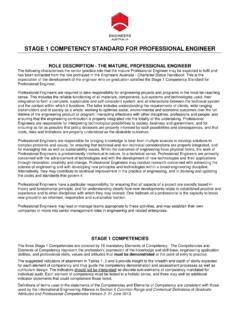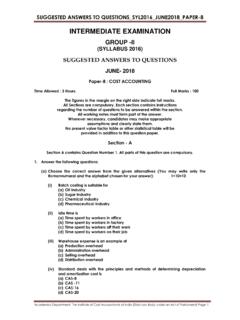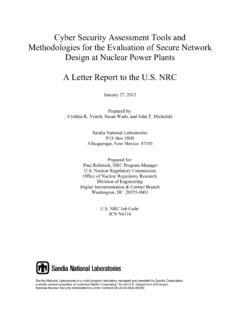Transcription of CONTROVERSIES IN MIXED METHODS RESEARCH
1 15. CONTROVERSIES IN. MIXED METHODS RESEARCH . John W. Creswell M. ixed METHODS has emerged in the last few years as a papers presented at conferences, articles published in the Jour- RESEARCH approach popular in many disciplines and nal of MIXED METHODS RESEARCH (JMMR) while I served as found- countries, and supported through diverse funding ing coeditor for the last five years, and papers sent to me by agencies. With such growth, it is not surprising that critical authors who wanted me to keep abreast of emerging issues. As I. commentaries have surfaced through papers presented at con- look across these diverse materials, I hope to foster the ongoing ferences and in published journal articles. These critics have conversation about the CONTROVERSIES and the many possible come from both within ( , Greene, 2008; Morse, 2005; answers that scholars have offered to them. Creswell, Plano Clark, & Garrett, 2008) and outside (Denzin &. Lincoln, 2005; Howe, 2004) the MIXED METHODS community.
2 Although concerns have mounted, they have been largely 2 Some Recent Questions ignored by social scientists and the MIXED METHODS community. This chapter gives voice and focus to these CONTROVERSIES . I Some of the CONTROVERSIES that I will present figured promi- discuss 11 far-ranging CONTROVERSIES from basic concerns about nently in a discussion in March 2009. I was attending and defining and describing MIXED METHODS , to philosophical presenting at the University of Aberdeen in Scotland (Creswell, debates, and on into the procedures for conducting a study. 2009d) at the Economic & Social RESEARCH Council (ESRC). For each controversy, I present critical questions, diverse Seminar Series sponsored by the Health Services RESEARCH stances, and lingering questions. At the end of this chapter, I Unit at the University of Aberdeen. I had finished my overview reflect on the implications of these CONTROVERSIES . I hope this of MIXED METHODS RESEARCH to a gathering of 50 scholars pri- discussion will help MIXED METHODS researchers, students, and marily from the health sciences.
3 They had assembled in his- policy makers appreciate the still-unanswered questions, view toric Elphinstone Hall, an ancient venue with a high, vaulted, the multiple perspectives that have emerged, and reflect on hammer-beam roof, banners hanging from the rafters, and new commitments that the MIXED METHODS field needs to oak-paneled walls lined with pictures of distinguished schol- make. For qualitative researchers, I hope that this reflection ars dating back centuries. Much to my surprise, the conference will encourage the continued discussion of the strong vital role organizer suddenly asked small groups to form and record that qualitative RESEARCH has and continues to play in MIXED their questions about both the advantages and the challenges METHODS RESEARCH . of using MIXED METHODS RESEARCH . Not wanting to miss a key The thoughts to follow will reflect my own writings of the last opportunity to capture their challenges and critical thoughts, I.
4 20 years and will include, at times, a self-reflective critique. My hastily began taking notes. They spoke about claims being methodological development consisted of formal training as a made about the value of MIXED METHODS RESEARCH ( Is MIXED postpositivist in the 1970s, self-education as a constructivist METHODS seen as the answer to everything? Are there undue through teaching qualitative courses in the 1980s, and advocacy expectations raised by MIXED METHODS that cannot be ful- for MIXED METHODS through my writings and teachings from the filled? ), about philosophical and theoretical issues ( Is there 1990s to the present. As one spokesperson for MIXED METHODS , opposition to MIXED METHODS from those who hold strong many CONTROVERSIES have come to my attention through scholarly worldview positions? Does a dominant paradigm prevail in 2 269. 270 2 PART III STRATEGIES OF INQUIRY. MIXED METHODS ? Is qualitative RESEARCH working on an even qualitative RESEARCH in MIXED METHODS (Creswell, Shope, Plano playing field with quantitative in MIXED METHODS ?))
5 , and about Clark, & Green, 2006), and at a panel presentation made at the the procedures and processes of RESEARCH ( Is there a good fit 2007 International Qualitative Inquiry Congress (Creswell, between the RESEARCH question and MIXED METHODS ? Do 2007). In light of these discussions, it is timely to address these researchers have expertise and competence in both areas? ). CONTROVERSIES . In this chapter, I address 11 CONTROVERSIES and raise The irony of new voices of concern about MIXED METHODS several questions, as outlined in Table The CONTROVERSIES , arising in the old, historic setting of Elphinstone Hall did not as a group, reflect what Kuhn (1970) said years ago about the escape my attention. But, in retrospect, hearing the issues was transition period in RESEARCH : not surprising. Concerns have been voiced in recent respected journal articles (Giddings, 2006; Howe, 2004), in the third edi- The proliferation of competing articulations, the willingness to tion of this handbook (Denzin & Lincoln, 2005), in conference try anything, the expression of explicit discontent, the recourse presentations (Holmes, 2006), and in articles published in the to philosophy, and to debate over fundamentals, all these are Journal of MIXED METHODS RESEARCH .
6 In 2006, I had presented my symptoms of a transition from normal to extraordinary views about unresolved issues in a journal article on the role of RESEARCH . (p. 91). Table Eleven Key CONTROVERSIES and Questions Being Raised in MIXED METHODS RESEARCH CONTROVERSIES Questions Being Raised 1. The changing and expanding definitions of What is MIXED METHODS RESEARCH ? How should it be defined? What shifts are being MIXED METHODS RESEARCH seen in its definition? 2. The questionable use of qualitative and Are the terms qualitative and quantitative useful descriptors? What inferences quantitative descriptors are made when these terms are used? Is there a binary distinction being made that does not hold in practice? 3. Is MIXED METHODS a new approach to RESEARCH ? When did the conceptualization of MIXED METHODS begin? Does MIXED METHODS predate the period often associated with its beginning? What initiatives began prior to the late 1980s? 4. What drives the interest in MIXED METHODS ?
7 How has interest grown in MIXED METHODS ? What is the role of funding agencies in its development? 5. Is the paradigm debate still being discussed? Can paradigms be MIXED ? What stances on paradigm use in MIXED METHODS have developed? Should the paradigm for MIXED METHODS be based on scholarly communities? 6. Does MIXED METHODS privilege postpositivism? In the privileging of postpositivism in MIXED METHODS , does it marginalize qualitative, interpretive approaches and relegate them to secondary status? 7. Is there a fixed discourse in MIXED METHODS ? Who controls the discourse about MIXED METHODS ? Is MIXED METHODS nearing a metanarrative? . 8. Should MIXED METHODS adopt a bilingual What is the language of MIXED METHODS RESEARCH ? Should the language be bilingual language for its terms? or reflect quantitative and qualitative terms? 9. Are there too many confusing design What designs should MIXED METHODS researchers use? Are the present designs possibilities for MIXED METHODS procedures?
8 Complex enough to reflect practice? Should entirely new ways of thinking about designs be adopted? 10. Is MIXED METHODS RESEARCH misappropriating Are the claims of MIXED METHODS overstated (because of misappropriation of other designs and procedures from other approaches approaches to RESEARCH )? Can MIXED METHODS be seen as an approach lodged within to RESEARCH ? a larger framework ( , ethnography)? 11. What value is added by MIXED METHODS beyond Does MIXED METHODS provide a better understanding of a RESEARCH problem than the value gained through quantitative or either quantitative or qualitative RESEARCH alone? How can the value of MIXED qualitative RESEARCH ? METHODS RESEARCH be substantiated through scholarly inquiry? Chapter 15 CONTROVERSIES in MIXED METHODS RESEARCH 2 271. 2 Changing and Expanding Definitions case study. Our definition of MIXED METHODS had both a philoso- phy and a method orientation, and it conveyed components of the Heading the list of CONTROVERSIES would certainly be the funda- core characteristics of MIXED METHODS that I advance today in mental question: What is MIXED METHODS RESEARCH ?
9 How workshops and presentations ( , see Creswell, 2009a). In MIXED should it be defined? To answer these questions requires a brief METHODS , the researcher historical review of shifts in the definition of MIXED METHODS collects and analyzes persuasively and rigorously both qualita- over the years. For example, an early definition of MIXED tive and quantitative data (based on RESEARCH questions);. METHODS came from writers in the field of evaluation, Greene, mixes (or integrates or links) the two forms of data concur- Caracelli, and Graham (1989). They emphasized the mixing of rently by combining them (or merging them), or sequentially METHODS and the disentanglement of METHODS and paradigms by having one build on the other, and in a way that gives prior- when they said, ity to one or to both;. uses these procedures in a single study or in multiple phases of In this study, we defined MIXED -method designs as those that a program of study;. include at least one quantitative method (designed to collect num- frames these procedures within philosophical worldviews and bers) and one qualitative method (designed to collect words), a theoretical lens; and where neither type of method is inherently linked to any particular combines the procedures into specific RESEARCH designs that inquiry paradigm.
10 (p. 256) direct the plan for conducting the study. Ten years later, the definition had shifted from mixing two These core characteristics have provided some common METHODS to mixing in all phases of the RESEARCH process, and features for describing MIXED METHODS RESEARCH . They evolved MIXED METHODS was being seen as a methodology (Tashakkori & from many years of reviewing MIXED METHODS articles and Teddlie, 1998). Included within this process would be mixing determining how researchers use both qualitative and quantita- from philosophical ( , worldview) positions, to final infer- tive METHODS in their studies. ences, and to the interpretations of results. Thus, Tashakkori I am not alone in proposing some common features. In a and Teddlie (1998) defined MIXED METHODS as the combination highly cited JMMR article, Johnson, Onwuegbuzie, and Turner of qualitative and quantitative approaches in the methodology (2007) suggested a composite definition for MIXED METHODS of a study (p.)
















